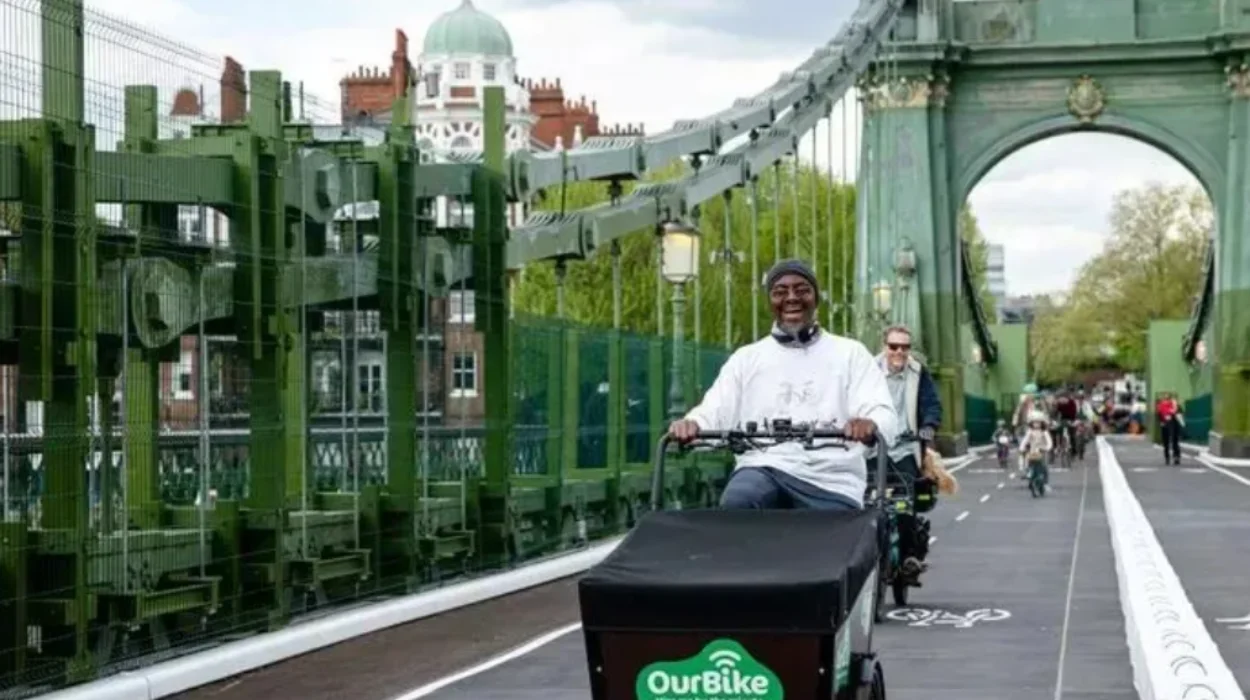Hammersmith & Fulham (Parliament Politics Magazine) – Hammersmith Bridge’s main carriageway reopens following a £2.9m upgrade, improving access and safety for pedestrians, cyclists, and e-scooter users.
After the engineers finished stabilizing the 138-year-old cast iron suspension bridge, new bike and pedestrian lanes were opened.
Now, there are three distinct lanes: one for northbound bikers, one for southbound cyclists, and a third two-way pedestrian walkway. Additionally, only pedestrians will be able to use the surrounding walkways.
Wheelchair users will benefit from the additional space provided by the new, wider pedestrian lane. E-cargo bikes are also being tested on the bridge to transport elderly and disabled persons as well as small children.
These bikes can fit between the recently erected anti-terror barges, which are 1.2 meters wide. They’ll make use of the bike lanes.
A £2.9 million grant from the Department for Transport (DfT) has been used to pay for the new decking.
Hammersmith & Fulham Council has been awarded £4.7 million by the DfT to support the bridge hangers that connect the deck to the suspension chains.
Cllr Sharon Holder, Cabinet Member for Public Realm, said:
“We are grateful to the DfT for the grant funding that has enabled us to re-open the main carriageway with new decking as well as carrying out the essential work to support the hangers.”
After our skilled engineers stabilized the Grade II*-listed Victorian bridge, the main highway was reopened.
Since Hammersmith Bridge was completely closed for safety reasons in August 2020, Hammersmith & Fulham Council has invested a total of £48 million in its restoration and upkeep.
Bus trips have become longer and connections more difficult due to the bridge shutdown, particularly for people with mobility impairments. Some support letting buses over, which calls for the bridge to be strengthened, but this might also result in calls for the bridge to be reopened to vehicles.
Some contend that restoring full transport capability requires the expensive and intricate repair of the bridge to provide room for cars, which is expected to cost around £250 million.
The Transport Minister has formally endorsed vehicle access by stating that he wants to see the bridge reopened to all traffic types.
While opponents highlight accessibility, pragmatic transportation demands, and political pledges to fully reopen the bridge to vehicles, supporters highlight environmental sustainability, heritage preservation, and the advantages of active travel.
For the main highway, their experts removed over 1,000 damaged deck and footway panels. The initial phase of re-decking is available for locals to view on YouTube.
Engineers restored the carriageway and walkways, implemented anti-terror safety measures on the ancient bridge, rebuilt all of the deteriorated wooden deck boards, and fixed several massive timbers that support the decking.
With a 1.5-tonne vehicle weight limit set by safety experts, H&F is testing e-mobility options to transport inhabitants across the bridge, particularly the elderly and disabled.
To avoid overloading the ancient structure, they will keep an eye on how many bikers and pedestrians may safely cross the bridge at once.
Modern engineering and meticulous preservation of one of the oldest suspension bridges in the world were integrated in the bridge stabilization project. The following steps were taken to finish it:
- After carefully planning off-site using a replica pedestal, our world-class engineers reinforced all four corner cast-iron pedestals using fiber-reinforced concrete.
- During the jacking operations, the historic structure was supported by specially designed steel frameworks.
- The steel was chopped into 1,220 custom pieces after being imported in 29 enormous sheets to create the frames.
- A hydraulic jacking mechanism was used to safely raise the bridge off its original Victorian bearings. This made it possible for engineers to swap out the seized bearings for more contemporary rubber ones, guaranteeing that the bridge can now react to movement and temperature changes without risk.
An inspection conducted by Hammersmith & Fulham Council found cracks in the cast-iron pedestals, which are essential parts that support the suspension system, necessitating the stabilization work. The bridge was in danger of collapsing due to these cracks.
The intricate and extraordinary labor necessary to completely restore the old bridge began with this phase. Still, the bridge is “sub-standard” and will need to be closely watched and undergo major repair in order to remain operational.
For the bridge’s long-term future, H&F and the DfT are presently evaluating a number of possibilities and engineering solutions.
The outdated and overstressed hangers on Hammersmith Bridge are being strengthened by engineers.
Along both sides of the ancient suspension bridge are the 172 hangers, which are poles that link the bridge deck to its suspension chains. These components attach to bearing joints, which enable the deck of the bridge to move and flex.
Before the deck-end bearings are replaced as part of the permanent repair, steel rods have been temporarily positioned to relieve the pressure on the hangers. Additionally, our crew greases the joints on a regular basis to help the suspension bridge move.
What are the main arguments for and against banning cars from Hammersmith Bridge?
By cutting down on pollution and traffic emissions, car removal helps London meet its climate goals. The bridge might develop into a famous car-free crossing that serves as a model for environmentally friendly urban transportation.
The bridge has serious structural problems and is a Grade II listed Victorian building. By permanently prohibiting automobiles, the bridge’s lifespan may be increased and the need for expensive, comprehensive maintenance could be decreased.
In addition to increasing safety and promoting active travel, reopening the main highway only to walkers, cyclists, and scooter users makes the crossing more accessible and enjoyable.
In an effort to control traffic flow and lessen total car use in the region rather than just alleviate congestion, tolls are being proposed on additional adjacent bridges.
Reopening the bridge to automobile traffic will make travel easier for drivers who now have to take lengthy diversions.


